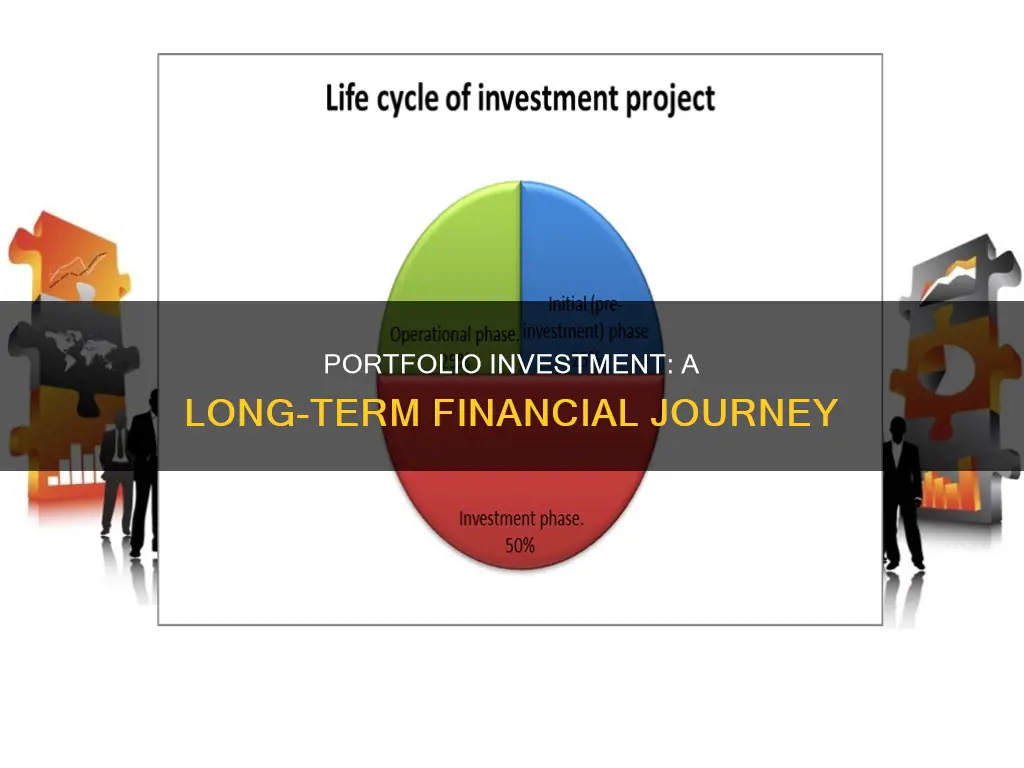
A portfolio investment is a collection of financial investments, such as stocks, bonds, commodities, cash, and cash equivalents, including closed-end funds and exchange-traded funds (ETFs). The goal of a portfolio investment is to generate returns and/or increase the value of the assets over time.
The process of portfolio investment involves acquiring and managing a diverse range of financial assets while balancing risk and maximising returns. The specific mix of assets in a portfolio depends on the investor's risk tolerance, financial goals, and timeline.
There are two main types of portfolio investment strategies: strategic investing, which involves acquiring assets for long-term growth or income, and tactical investing, which involves active trading to capitalise on short-term market movements.
By understanding the different asset classes, assessing their risk tolerance and financial goals, and regularly reviewing and rebalancing their portfolio, investors can build a successful portfolio that meets their financial objectives.
| Characteristics | Values |
|---|---|
| Definition | A portfolio investment is ownership of a stock, bond, or other financial asset with the expectation that it will earn a return or grow in value over time. |
| Investment types | Stocks, bonds, cash equivalents, real estate, commodities, and alternative investments like cryptocurrencies, private equity, or hedge funds. |
| Investment approach | Strategic or tactical. |
| Strategic investing | Acquiring assets that are expected to grow significantly over time or generate consistent income. |
| Tactical investing | Actively trading to capitalize on short-term market movements. |
| Investment allocation styles | Conservative, income-focused, moderate, growth-oriented, aggressive. |
| Conservative investors | Prefer preserving savings or capital and income and typically have a higher proportion of bonds and cash equivalents. |
| Income-focused investors | Opt for regular cash flow from dividends and interest payments. |
| Moderate investors | Aim to balance risk and return with a more even mix of stocks and bonds. |
| Growth-oriented investors | Emphasize capital appreciation, with a larger share of stocks to potentially achieve higher long-term returns. |
| Aggressive investors | Maximize exposure to stocks and higher-risk assets, suitable for those with high-risk tolerance and longer investment horizons. |
| Diversification | An important strategy to manage risk and potentially improve returns. |
| Regular portfolio rebalancing | Important to maintain the desired asset allocation since market moves can alter the portfolio's composition. |
What You'll Learn

Diversification of investments
Diversification is a key concept in portfolio management. It is the simplest way to boost your investment returns while reducing risk. Diversification is a risk management strategy that creates a mix of various investments within a portfolio. A diversified portfolio contains a mix of distinct asset types and investment vehicles in an attempt to limit exposure to any single asset or risk.
The rationale behind diversification is that a portfolio constructed of different kinds of assets will, on average, yield higher long-term returns and lower the risk of any individual holding or security. The benefits of diversification hold only if the securities in the portfolio are not perfectly correlated—that is, they respond differently, often in opposing ways, to market influences.
There are many ways to diversify a portfolio. The three main general asset classes in an investment portfolio are stocks, bonds, and cash. Stocks allow investors to own a piece of a company and offer the highest long-term gains but are volatile, especially in a cooling economy. Bonds pay interest to investors who lend money to a company or government and are income generators with modest returns but are usually weaker during an expanding economy. Cash is low on both risk and return counts. It can buffer volatility or unexpected expenses and acts as “dry gunpowder” to invest during opportune times.
Other asset classes include precious metals, alternative investments such as cryptocurrency, options, futures, commodities, and real estate. Diversification can also be achieved by purchasing investments in different countries, industries, sizes of companies, or term lengths for income-generating investments.
The benefits of diversification are that it reduces overall risk while increasing the potential for overall return. That’s because some assets will perform well while others do poorly. A well-diversified portfolio tends to earn the market’s average long-term historic return. Owning a variety of assets minimizes the chances of any one asset hurting your portfolio. The trade-off is that you never fully capture the startling gains of a shooting star. The net effect of diversification is slow and steady performance and smoother returns, never moving up or down too quickly. That reduced volatility puts many investors at ease.
Diversification is an easy way to reduce risk in your portfolio, but it can’t eliminate it altogether. Investments still have two broad types of risk: market risk (systematic risk) and asset-specific risks (unsystematic risk). While diversification can radically reduce asset-specific risk, there’s just no way to get rid of market risk.
When creating a diversification strategy for your portfolio, remember that diversification is about variety. You can achieve diversification by investing in different asset classes, within asset classes, and beyond asset classes.
The Perfect Investment Portfolio: Strategies for Success
You may want to see also

Risk tolerance and asset allocation
Risk tolerance is the degree of risk an investor is willing to take on, given the volatility in the value of an investment. It often determines the type and amount of investments that an individual chooses. For example, greater risk tolerance is associated with investments in stocks, equity funds, and exchange-traded funds (ETFs), while lower risk tolerance is associated with the purchase of bonds, bond funds, and income funds.
An investor's risk tolerance is influenced by factors such as age, investment goals, and income. An aggressive investor, often with a higher risk tolerance, is willing to risk losing money to achieve potentially better results. Their investments emphasize capital appreciation rather than income preservation. On the other hand, a conservative investor, with a lower risk tolerance, seeks investments with guaranteed returns and is willing to accept little to no volatility in their portfolio.
When constructing a portfolio, it is important to consider an individual's risk tolerance. Portfolios can range from conservative to aggressive, depending on the investor's risk appetite. A conservative portfolio allocates a larger percentage of the total to lower-risk securities such as fixed-income and money market securities, with the primary goal of protecting the principal value. In contrast, an aggressive portfolio mainly consists of equities, resulting in wider fluctuations in value.
The ideal asset allocation depends on an investor's risk tolerance, age, financial goals, and time horizon. A common rule of thumb is the "100 minus age" rule, which suggests investing a percentage of your portfolio in stocks equivalent to 100 minus your age, with the remainder in bonds and safer assets. However, this may need adjustment to match an investor's specific goals and time horizon.
It is important to note that asset allocation is not a one-time decision. Regular portfolio reviews and adjustments are necessary to ensure the portfolio aligns with changing financial needs and goals.
Savings or Investing: Which Offers Better Liquidity?
You may want to see also

Investment portfolio horizons
The length of an investment horizon is an important factor in determining the level of risk an investor is willing to take on. Generally, investors with longer horizons can tolerate more risk, as they have more time to recover from potential losses. Conversely, those with shorter horizons should be more conservative in their investment choices.
For instance, a young professional saving for retirement may have a higher allocation of stocks in their portfolio to maximize growth potential. As they approach retirement, they may shift their portfolio to include more bonds, which are considered less risky.
It's important to note that while a longer horizon may allow for more risk-taking, it doesn't justify making extremely risky trades. Instead, longer-term investors may opt for riskier types of equities, such as mid-cap, small-cap, or high-growth stocks.
Additionally, investors with a higher risk tolerance may favour investments in growth stocks, real estate, international securities, and options. On the other hand, more conservative investors typically prefer government bonds and blue-chip stocks.
Understanding one's investment horizon is crucial in determining the appropriate asset allocation and risk level for their portfolio. It ensures that investment choices align with the investor's financial goals, risk tolerance, and time frame.
Understanding Your Investment Portfolio: A Beginner's Guide
You may want to see also

Active vs passive management
A portfolio is a collection of financial investments like stocks, bonds, commodities, cash, and cash equivalents, including closed-end funds and exchange-traded funds (ETFs). The word "portfolio" comes from the Latin "folium", meaning "to carry leaves".
When you use a portfolio for investment purposes, you expect that the stock, bond, or another financial asset will earn a return or grow in value over time, or both. A portfolio investment may be either strategic, where you buy financial assets with the intention of holding onto those assets for a long time, or tactical, where you actively buy and sell the asset, hoping to achieve short-term gains.
There are two main investment strategies that can be used to generate a return on investment accounts: active portfolio management and passive portfolio management.
Active Portfolio Management
Active portfolio management focuses on outperforming the market in comparison to a specific benchmark such as the Standard & Poor's 500 Index. Active management requires frequent buying and selling in an effort to beat a specific benchmark or index. An active portfolio manager will follow market trends, shifts in the economy, changes to the political landscape, and any other factors that may affect specific companies. This data is used to time the purchase or sale of assets. Active management portfolios strive for superior returns but take greater risks and entail larger fees.
Passive Portfolio Management
Passive portfolio management, also known as index fund management, mimics the investment holdings of a particular index in order to achieve similar results. A passive portfolio is designed to parallel the returns of a particular market index or benchmark as closely as possible. The purpose of passive portfolio management is to generate a return that matches the chosen index. Passive management replicates a specific benchmark or index in order to match its performance. Passive strategies do not have a management team making investment decisions and can be structured as an exchange-traded fund (ETF), a mutual fund, or a unit investment trust (UIT). Passive investments have very low fees, good transparency, and are tax-efficient.
The choice between active and passive investing depends on the type of investments chosen. Passive management generally works best for easily traded, well-known holdings like stocks in large US corporations. Active management may be more beneficial for certain niche markets, like emerging-market and small-company stocks, where assets are less liquid and fewer people are watching.
Market conditions also play a role in the choice between active and passive investing. When the market is volatile or the economy is weakening, active managers may outperform. On the other hand, when specific securities within the market are moving in unison or equity valuations are more uniform, passive strategies may be preferable.
A blended strategy that combines both active and passive approaches can benefit from the insights gained from each method and may be the best approach for investors.
Saving Relationships: Worth the Investment?
You may want to see also

Regular portfolio rebalancing
Rebalancing is the process of buying and selling portions of your portfolio to set the weight of each asset class back to its original state. It is recommended that a portfolio should be rebalanced at least once a year, but this is a personal decision that depends on factors such as age, risk tolerance, and transaction costs. More frequent rebalancing may be necessary if you are nearing retirement and need to maximise your gains.
There are two main types of portfolio rebalancing: calendar rebalancing and trigger rebalancing. Calendar rebalancing involves reviewing your portfolio at certain times of the year to determine whether rebalancing is necessary. This could be done monthly, quarterly, or annually. Trigger rebalancing, on the other hand, involves rebalancing your portfolio any time the allocations have drifted by a certain amount from your desired allocation. For example, you may choose to rebalance whenever allocations have shifted by 5% or more.
When rebalancing your portfolio, it is important to consider the tax implications of selling profitable investments. One way to avoid taxes is to place your portfolio in a tax-advantaged account, such as an individual retirement account (IRA). This way, you will only be taxed when you start withdrawing from the account, rather than when you sell investments to rebalance your portfolio. Another strategy is to rebalance with portfolio cash flows. Instead of buying or selling investments, you can move dividends and interest to your portfolio's underweighted asset classes.
By regularly rebalancing your portfolio, you can ensure that your investments remain diversified and aligned with your financial goals and risk tolerance.
Strategies for Allocating Your Investment Portfolio Wisely
You may want to see also
Frequently asked questions
A portfolio investment is a collection of financial investments such as stocks, bonds, commodities, cash, and cash equivalents. It can also include less traditional investments like real estate, art, and private investments.
Building a portfolio starts with understanding the different asset classes like stocks, bonds, and real estate. Then, assess your investment goals and risk tolerance to determine how much of each asset class to include. Regularly review and rebalance your portfolio to maintain your desired mix of assets.
Strategic investing involves buying assets expected to grow over time or generate consistent income, and holding them for the long term. Tactical investing, on the other hand, involves active trading to capitalise on short-term market movements.
Managing risk involves diversifying your investments across different asset classes, sectors, and geographic regions. This helps to reduce the impact of any single investment's poor performance. Regularly rebalancing your portfolio to maintain your desired asset allocation is also key to managing risk.







